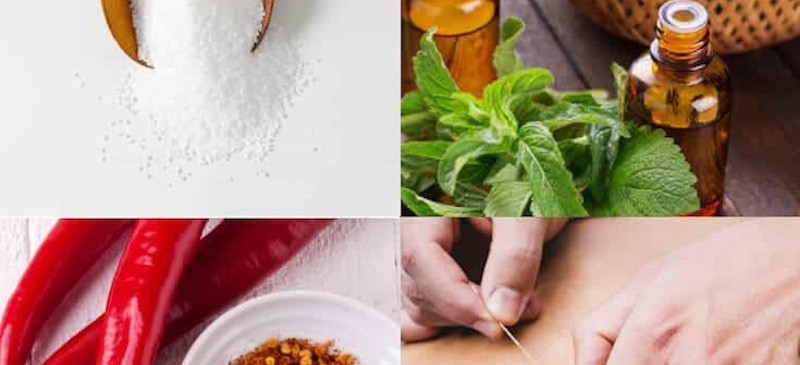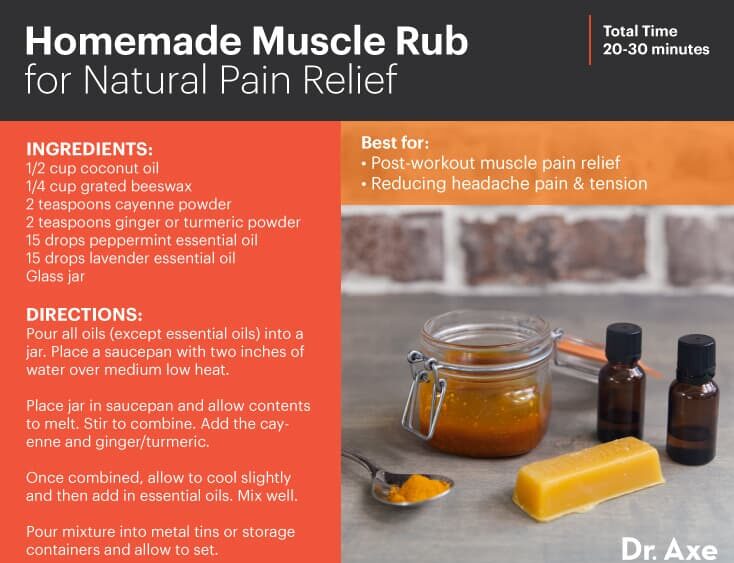8 Surprising Natural Painkillers You’ll Love
- 8 Natural Painkillers
- The Dangers of Prescription Painkillers

Painkilling drugs can perform miracles for patients in need, but they can also be highly addictive and potentially give rise to serious side effects. Even acetaminophen, the main component of Tylenol, influences us in ways that we are only now beginning to fully comprehend – it makes people less empathetic – making it more crucial than ever to turn to safer, scientifically verified natural painkillers when we experience discomfort or are coping with chronic pain.
Luckily, there is a wide range of natural painkillers to select from. Let’s take a closer look.
8 Natural Painkillers
1. Painfully Spicy Foods
If you have a penchant for hot and spicy foods, you probably know that a certain level of pain is involved. Intriguingly, however, hot foods like wasabi and cayenne pepper can actually act as natural painkillers.
The benefits of cayenne pepper include several types of natural pain alleviation. This powerful pepper effectively helps relieve post-operative pain, including pain after a mastectomy or amputation.
Cayenne pepper is also a potent candida killer. Scientists discovered that it is active against 16 different fungal strains, including candida, a common internal infection linked to joint pain and other candida symptoms.
Cayenne also offers external pain relief. Capsaicin, an important natural painkiller found in cayenne, helps treat muscle soreness, tension, and even skin infections. Look for it in natural painkilling creams.
Wasabi is another spicy food with natural painkilling properties. Scientists are researching the isothiocyanates in wasabi as potential pain relievers. Researchers from the University of California San Francisco made a discovery suggesting that isothiocyanates could block an inflammation receptor, making it a potentially significant natural painkiller.
2. Powerful Pain-Relieving Oils
Evening Primrose Oil for Menstrual Pain
Evening primrose oil, which is naturally abundant in the essential fatty acid gamma-linolenic acid, is gaining more popularity worldwide as a natural treatment for premenstrual syndrome (PMS). Many women take it to alleviate common premenstrual symptoms, including pain, thanks to its hormone-balancing effects.
Take 1,500 milligrams starting on the first day of your period and continue until ovulation. If you’re on certain antidepressants, have a bleeding or seizure disorder, are on phenothiazine drugs for schizophrenia, or are being treated for high blood pressure, you should consult your doctor before starting evening primrose oil.
Arnica Oil for Bruises and Carpal Tunnel Pain
Not as well-known as many other essential oils, arnica oil should have a place in every medicine cabinet. Generally considered safe for topical use, arnica oil applied to the skin helps ease inflammatory pain associated with insect bites, bruises, and even arthritis flare-ups.
To treat bruises, applying arnica oil twice daily (as long as the skin is not broken) may help reduce bruising inflammation even more effectively than low-concentration vitamin K formulations.
When it comes to carpal tunnel relief, arnica oil is also a wise choice in the realm of natural painkillers. For some, it helps reduce pain to the extent that carpal tunnel surgery is not necessary. For others, arnica oil is a proven method to help lower inflammation and associated pain in the weeks following carpal tunnel surgery.
Lavender and Peppermint Oils for Muscle Pain and Headache Relief
One of the advantages of peppermint oil lies in its natural painkiller and muscle-relaxant properties. It has even been shown to help alleviate fibromyalgia and myofascial pain syndrome.
For natural headache relief, two essential oils combine for natural pain relief. Peppermint oil improves circulation, and lavender reduces muscle tension – two effective ways to quickly stop a headache in its tracks.
Try placing a few drops of peppermint or lavender oil in your hands and then rubbing the blend on your forehead, temples, and the back of your neck. You can also dilute a few drops by mixing the essential oils with almond, grapeseed, or coconut oil.
The peppermint-lavender combination also works together to reduce post-workout muscle pain. This handy homemade muscle rub recipe also helps relieve sore muscles:

Note: Certain essential oils possess remarkable pain-reducing qualities. (As always, it’s important to use essential oils as directed because these plant-based compounds are potent, so be sure to mix with carrier oils appropriately when necessary.)
3. Epsom Salt
You might already be aware that magnesium-rich Epsom salt is a natural painkiller for bone and joint pain as well as muscle soreness. (It’s a preferred remedy for heel spur pain, specifically.) Epsom salt can also be handy when you’re dealing with a painful splinter or even post-childbirth soreness.
Soaking the area affected by a splinter in warm water and Epsom salt helps painlessly extract the splinter. A sitz bath containing Epsom salt can help increase magnesium and suppress inflammation associated with soreness after childbirth.
4. Self Myofascial Release
Foam roller exercises are a form of self myofascial release that, although sometimes slightly painful, actually eliminate those persistent muscle knots while helping you correct muscle imbalances that lead to poor posture and related musculoskeletal pain. It’s also an emerging treatment to reduce your risk of developing delayed muscle onset soreness, a common exercise-related pain that keeps people away from the gym.
5. Drink Your Great-Grandma’s Go-To Broth
In the “olden days,” our ancestors were reluctant to waste any part of an animal used for food. Consequently, back then, bone broth was a regular part of almost everyone’s diet. Made from bones, marrow, skin, feet, tendons, and ligaments, this old-fashioned stock provided a generous dose of collagen, proline, glycine, and glutamine that is largely absent from the modern American diet.
Bone broths contain minerals in forms that your body can absorb easily: calcium, magnesium, phosphorus, silicon, sulphur, and others. They contain chondroitin sulfate and glucosamine, the compounds sold as expensive supplements to reduce inflammation, arthritis, and joint pain. You can try this Chicken Bone Broth Recipe or Beef Bone Broth Recipe.
One of the reasons bone broth serves as such a powerful natural painkiller is its ability to act as a soft cushion to assist bones in gliding without friction due to its gelatin content. Think of it as an anti-aging agent for joints.
6. Graston Technique
Digging a metal tool into a painful spot, such as the bottom of your foot if you have plantar fasciitis, might sound like a medieval torture method. The Graston technique is an instrument-aided manual therapy that serves as a non-invasive way to address soft tissue disorders like Achilles tendonitis, carpal tunnel syndrome, fibromyalgia, shin splints, back and shoulder pain, and other conditions.
It has even been proven to help relieve pain associated with chronic conditions like trigger finger and post-surgery pain in a manner that can reduce the amount of painkillers administered.
The technique works by targeting scar tissues, alerting the body’s immune system that it is an area that requires targeting and healing.
7. Needles
When you envision a needle piercing your skin, the last thing you might expect is natural pain relief. The truth is, though, that dry needling works by stimulating trigger points to reduce pain or disability.
A 2007 study found that dry needling significantly reduced shoulder pain by targeting a trigger point. Dry needling can also assist in dealing with trigger points that restrict a person’s range of motion, which can lead to severe pain and musculoskeletal side effects.
Acupuncture is another needle therapy recognized as a natural painkiller. It has been found to help relieve chronic pain in numerous studies.
8. Rolfing
Could you find pain relief through a method that focuses on soft tissue manipulation and your psyche? The answer is yes.
Rolfing, also known as structural integration, involves soft tissue work and movement education to realign your body’s myofascial structure with gravity. (Imagine your body’s fascia as the “netting” that envelopes your muscles and organs.)
Rolfing not only alleviates physical muscle pain rooted in your fascia but also enhances your emotional well-being and energy. Whether you’re an athlete aiming to improve your performance or someone suffering from TMJ pain, chronic back pain, or spine pain, rolfing is worth exploring. It’s a potent natural painkiller that positively affects your neuromuscular system without the need for pills.
Other potential natural painkillers include:
- white willow bark
- chiropractic adjustments
- tai chi
- gua sha
- massage therapy
- yoga
- turmeric
- frankincense oil/boswellia
- holy basil
- chili peppers
- wintergreen oil
- ginger oil
- rosemary oil
- helichrysum
- hyaluronic acid
- omega-3
- proteolytic enzymes (bromelain, papain)
- active release technique
- Feldenkrais technique
- pilates
- gyrotonic
- deep tissue massage
- PRP treatment
- stem cell therapy
- acupressure
- infrared sauna
- hydrotherapy
- cryotherapy
- vitamin D
- progressive muscle relaxation
- and more
The Dangers of Prescription Painkillers
There is no denying that prescription painkillers can reduce your pain. The issue is that you often require increasing amounts to suppress pain associated with chronic symptoms. Even worse, overdoses and addiction are becoming increasingly common, highlighting the importance of natural painkillers more than ever.

The three most common prescription painkillers are oxycodone, hydrocodone, and methadone. Try seeking natural painkillers before opting for these potentially addictive and harmful solutions. The controversial botanical substance kratom is also sometimes used to combat opioid addiction and provide pain relief.
Final Thoughts
Prescription and over-the-counter painkillers aid in pain relief but come with a host of side effects. Side effects of aspirin include stomach ulcers and breathing problems, while prescription painkillers are blamed for a growing number of overdose deaths.
Natural painkillers that focus on breaking up muscle adhesions and trigger points, along with posture improvements and pain-fighting essential oils, can significantly contribute to making you feel better without resorting to addictive and harmful over-the-counter and prescription pills.





